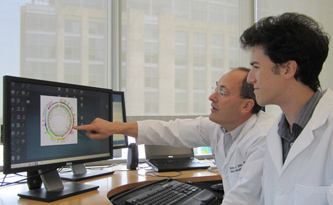 Adam Aronson
Adam Aronson
Her3 (ERBB3) mutations in breast cancer affect a tumor’s behavior and response to treatment. Her2-enriched breast cancer is a breast cancer subtype defined by microarray signature and 9% of Her2-enriched breast cancers are found to carry a Her3 mutation. Because Her3 and Her2 are closely related receptor tyrosine kinases which dimerize together and form a functional pair in cancer cells, and because Her2 is a major drug target in breast cancer therapy, we expect that Her3 mutations will have a major effect on a tumor’s clinical behavior and response to treatment. To test this hypothesis, we are creating 3 lines of tumor cells expressing different Her3 mutations in order to determine if these mutations alter the oncogenic properties of breast epithelial cells and if these cells are sensitized to drugs which target Her2-Her3. We anticipate that introduction of mutant Her3 into MCF10A-Her2 cells will produce resistance to the Her2 targeted antibody trastuzumab but may sensitize cells to the antibody pertuzimab, which is known to directly block Her2-Her3 interaction. This research will provide information on how to use gene mutation information from human cancers to guide patient treatment and identify better treatment strategies for women with Her2 enriched breast cancer.
 Natalie Macaruso
Natalie Macaruso
Astrocytomas are aggressive, invasive brain tumors that affect both adults and children and have a uniformly poor prognosis. Recently, our lab has found that nucleolin (NCL), a nucleolar protein normally expressed in rapidly proliferating cells, is also increasingly expressed in astrocytomas. Additionally, NCL knockdown has been shown to provide an anti-proliferative effect on these cells. However, little is known about the molecular mechanisms by which NCL promotes growth and proliferation. Our lab is exploring these mechanisms by generating a panel of deletion mutants that target specific activities (e.g. protein-protein interaction or rRNA processing) of NCL associated with motifs and domains within the protein. These mutants will be transfected into NCL knockdown glioblastoma cells to observe whether they are sufficient to rescue the cells and allow growth and proliferation. In addition, NCL is primarily expressed in the nucleolus, but a significant population also exists at the cell surface. Other mutants will be generated to affect localization of NCL within the astrocyte to determine which population is required for the increased cell growth and proliferation seen with NCL overexpression. A better understanding of the molecular pathways connecting nucleolin to cell proliferation will allow development of therapeutic agents targeting this pathway for the treatment of astrocytomas.
